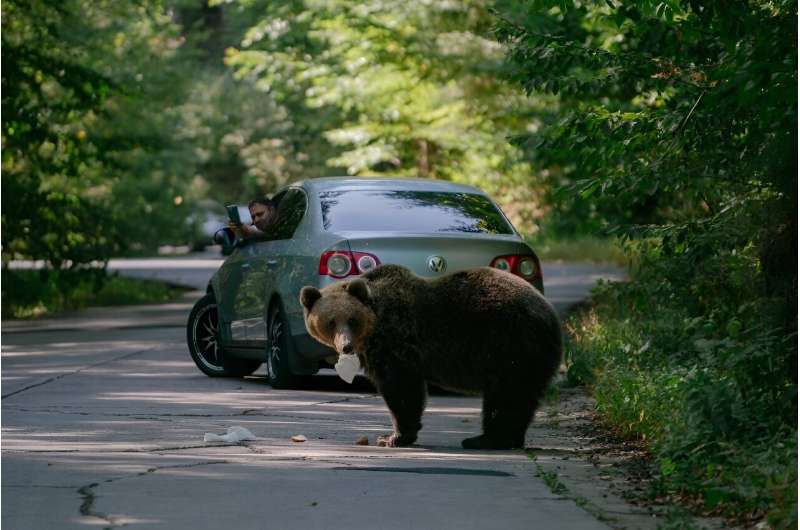
A bear eats a sandwich thrown by a passing driver, who films the animal with his mobile phone.
It was a sight that stopped traffic. A brown bear seemingly asleep, its head on its paws, on a winding forest road in central Romania, some paper napkins by its side.
“It’s amazing,” said Mike, a 72-year-old Israeli tourist. “I thought it might be dead.”
But the bear was just taking a rest after a sandwich, one of many thrown by tourists traveling Transylvania so they can get a great holiday snap.
In Romania, home to Europe’s largest brown bear population outside Russia, attacks are on the rise as the bears venture out of the forests looking for food, often brought by tourists or left in unsecured garbage cans.
The problem is pitting herders and farmers against conservationists, with authorities dramatically upping the number of bears that can be culled this year by 50 percent to 220. And some MPs want that number doubled.
Those pushing for higher quotas paint the bears as a threat, and claim their numbers are surging, with the environment ministry estimating the population at 8,000.
But experts counter that outdated, inaccurate methods are used to count the species protected by an EU directive to ensure their conservation.
Results of a census using DNA to ensure roaming bears are not counted several times are still pending.
Conservationists argue it is possible to better manage human-bear conflict rather than killing the animals.
A bear stretches out in the middle of the road near Covasna, Romania, waiting for his next meal.
‘Not romantic at all’
But several locals in the Carpathian Mountains told AFP they were alarmed by increased bear sightings.
Fourteen people have died and 158 were injured in attacks between 2016 and 2021, according to official figures.
Herder Tibor Fekete, who tends 70 cows in mountain pastures near the road to Lake Saint Anne, wants bears to be shot. He said they killed three of his cows this year.
“Bears cause damage and put our lives at risk,” said the 40-year-old, who complained of the cost of keeping six dogs to protect the herd.
Last month a bear also entered a schoolyard in Miercurea Ciuc, 30 kilometers (20 miles) away, and climbed up a tree.
An intervention team killed the animal rather than chasing it away or tranquilising it, saying they were ensuring the safety of the school’s 1,700-plus pupils.
A boy feeds dogs used to protect cattle from bears near Lazaresti Romania.
Bears can still attack when darted with a tranquiliser, said Miercurea Ciuc’s mayor Attila Korodi, a three-time environment minister and advocate of more culling. “And who takes responsibility when someone is hurt?”
He said more bears had been chased off the town’s streets this year than last.
“I think Europe sees Romania not only as some sort of a sanctuary but as a museum where everything must stay as it is,” Korodi told AFP.
“Day-to-day life with bears is not romantic at all,” he said.
Trophy hunting of bears has been banned in Romania since 2016 and only “specialized technical personnel” are allowed to shoot the animals.
Lawmakers, led by Barna Tanczos—until recently environment minister and another proponent of bear culling—have tabled a bill to allow the killing of nearly 500 bears a year.
The bears draw tourist to Romania’s Carpathian Mountains.
Otherwise bears will end up roaming lowland areas, like the capital Bucharest, Tanczos claimed, or “bathing in the Danube Delta”.
His claims are challenged by conservationists, who fear the ever increasing quotas could open the door to trophy hunting.
They say bears that cause no trouble are being shot.
‘Bear-smart community’
Not far from Miercurea Ciuc, the small touristy mountain town of Baile Tusnad is looking to become a “bear-smart community”.
“We have to understand bears won’t disappear from this area. But if the bear doesn’t feel safe, it doesn’t stay in town,” 36-year-old biologist Istvan Imecs told AFP.
He was scathing of tourists—foreigners and Romanians alike—who fed bears, which is illegal.
With advice from Imecs and conservation groups like WWF, the town is testing bear-proof rubbish containers, and has installed 400 electric fences around houses and bins.
There is also an app explaining what to do to avoid conflict with the animals.
From 50 damage complaints filed in 2021, the town has seen the number drop to zero in 2022 and 2023.
Laci, a resident who only gave his first name, installed an electric fence years ago.
“Anyone in Tusnad who says he’s not scared of bears is either a liar or stupid,” the 47-year-old said.
“We just got used to living together. There’s no other way.”
© 2023 AFP
Citation:
Keep or cull? Romania divided over its bear population (2023, October 23)
retrieved 23 October 2023
from https://phys.org/news/2023-10-cull-romania-population.html
This document is subject to copyright. Apart from any fair dealing for the purpose of private study or research, no
part may be reproduced without the written permission. The content is provided for information purposes only.
>>> Read full article>>>
Copyright for syndicated content belongs to the linked Source : Phys.org – https://phys.org/news/2023-10-cull-romania-population.html
